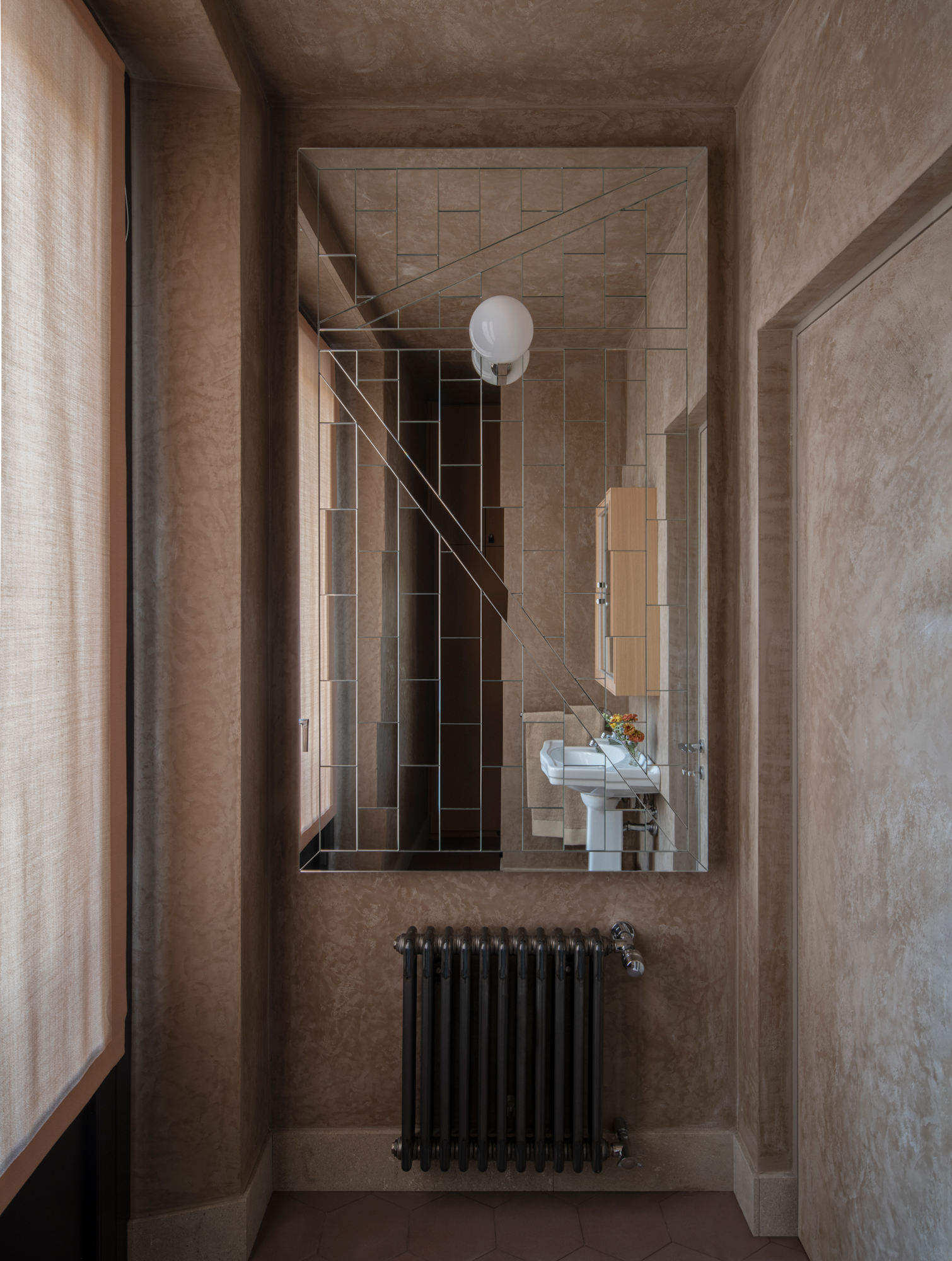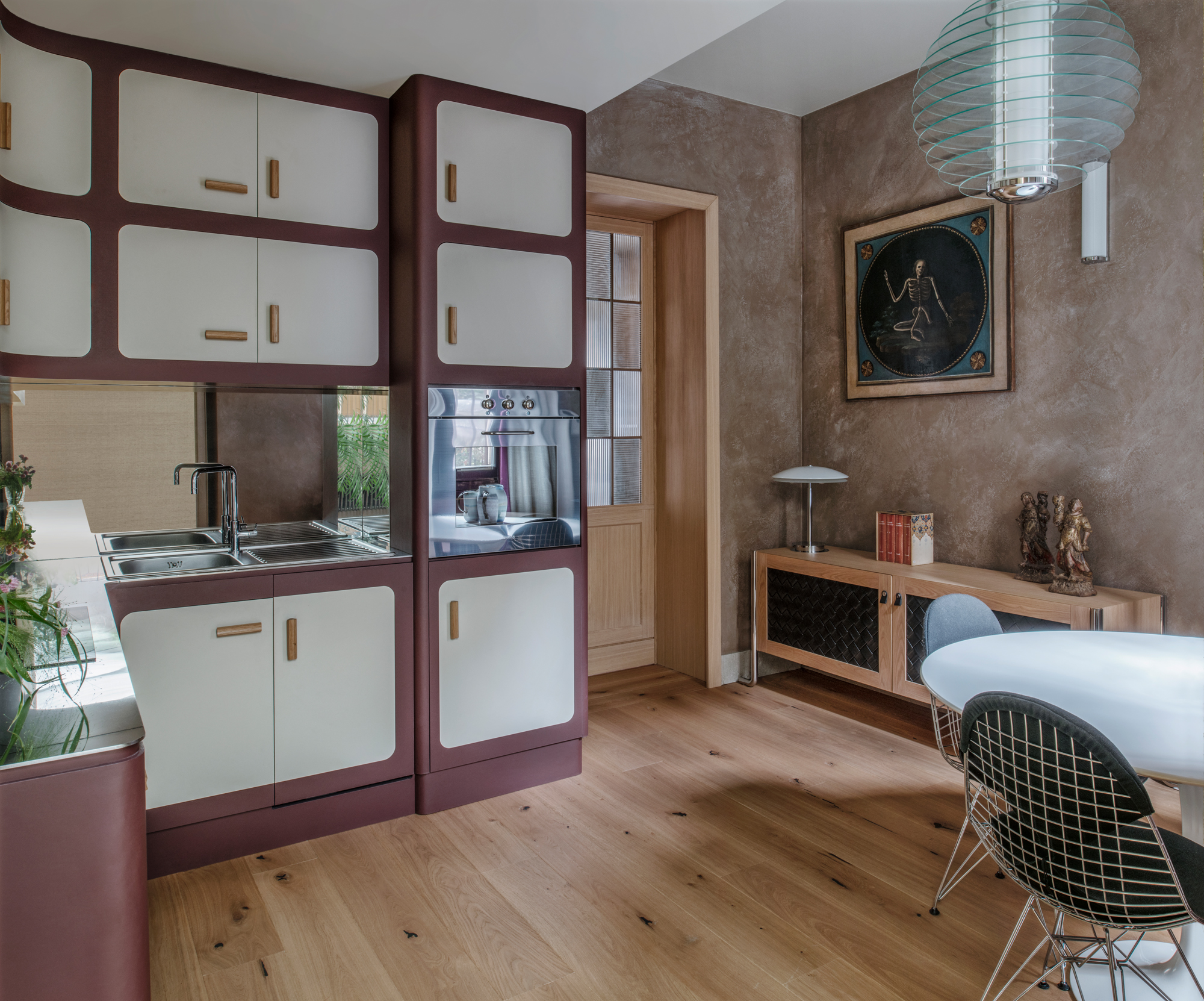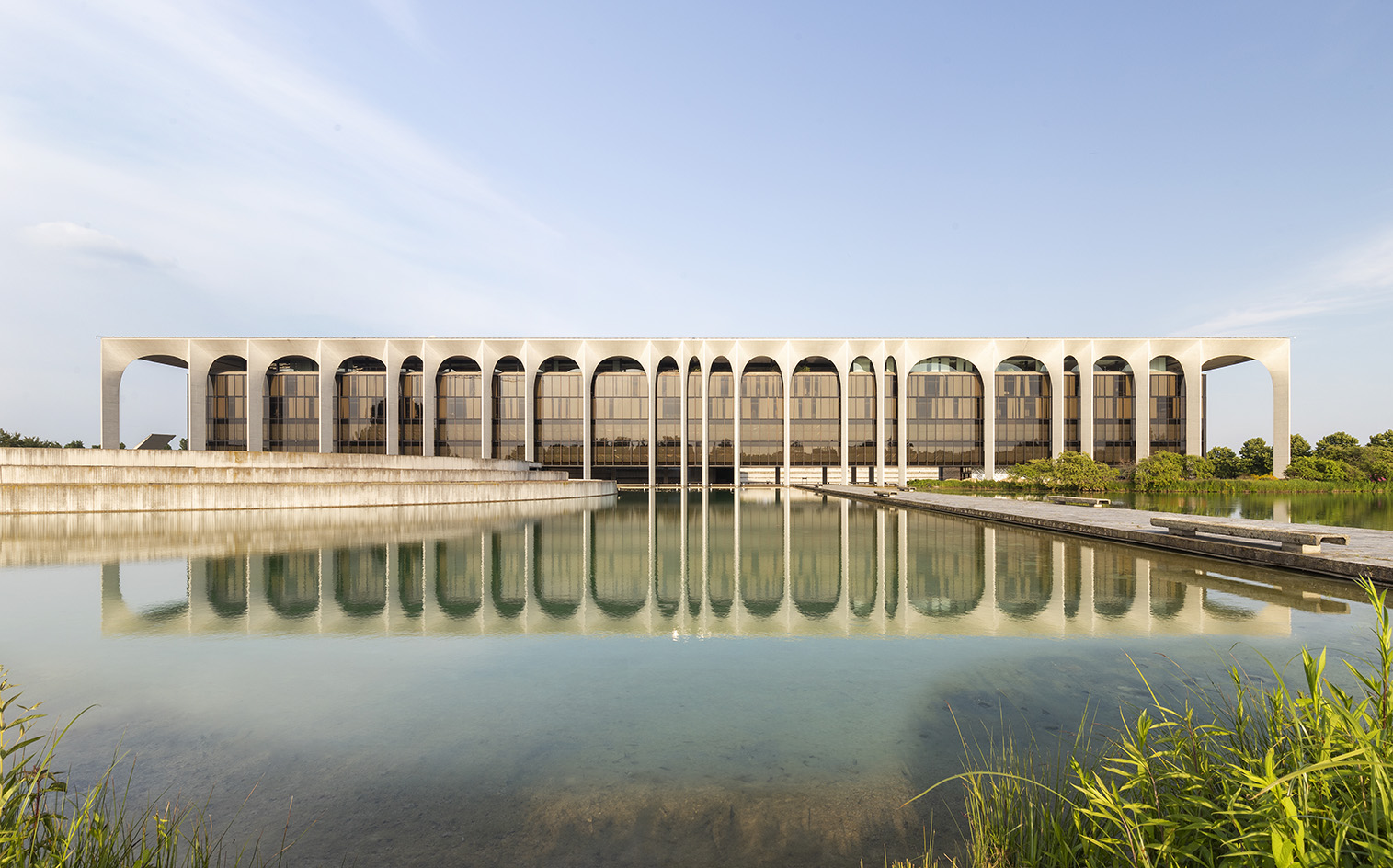Luca Guadagnino’s Milan apartment design is an ode to timelessness
A nostalgia-infused Milanese pad by Studio Luca Guadagnino has real screen presence
Mikael Olsson - Photography

Entering a Milan apartment living room one flight up from a narrow cobbled street, Luca Guadagnino settles into a Carlo Mollino theatre seat he had reupholstered in a thick, chocolate-coloured Dedar bouclé. Outside, the midday traffic rumbles and roars. But in this yesteryear-inspired apartment interior design he created with wadded silk walls and the antiquatedly discreet charm of the Milanese bourgeoisie, the urban world beyond is hushed and invisible as Guadagnino begins to deliver his thoughts in the rapid-fire clip of a man with two full-time jobs: renowned movie director and upstart interior architect.

A 1928 oil painting by Ettore Cosomati, from Luca Guadagnino’s own collection, hangs in the master bedroom, which is clad in Dedar’s ‘Fanfara’ raw silk wall fabric
‘Nostalgia plays a fundamental role for all of us,’ he says, dressed in well-worn layers of black, so nostalgic himself that he carries a Nokia dumbphone. ‘To be alive means paying the emotional price of always yearning for a return to something lost.’ As a filmmaker, Guadagnino has treated his audiences to minutely detailed settings in retro saturated colours, their grandeur belonging to no particular era, but with a poignant sense of wistful Italianate beauty. As a designer, or rather, as the creative director of the nine-person Studio Luca Guadagnino, he and his team of architects have found a way to turn that backward-longing gaze into contemporary interiors. He considers his output completely diverse. ‘In cinema, the spaces you create are flat and narrate a character,’ he explains. ‘In design, spaces are three-dimensional and in the service of their owners – a different relationship completely.’ Yet a Guadagnino space, in film or in real life, communicates in the same poetry of emotion.
‘It’s not a matter of “vintage” but of timelessness,’ says Stefano Baisi, an architect in Guadagnino’s studio who designed this Milan apartment together with the director. Timelessness can also be new: the Svenskt Tenn couch Baisi sits on is covered in a modern Dedar fabric, the globe lights above him are by Michael Anastassiades, the tile-cut mirror is by Studio Luca Guadagnino itself.

The guest bathroom, with a bespoke mirror by Studio Luca Guadagnino and Moroccan tadelakt walls
The apartment – actually two small apartments now joined internally by an oak staircase, in a casa di ringhiera, a classic Milanese building with long balustraded open-air corridors – belongs to Federico Marchetti, the fashion technology mogul and founder of Yoox, and a two-decade-long friend of Guadagnino. Though Marchetti and his wife, the journalist Kerry Olsen, moved to much larger Milan digs nine years ago, he held onto this apartment (‘a very dear part of my biography’, as he calls it, where he first lived as a student) as a pied-à-terre for guests, and handed its redesign over to his friend.
It was Marchetti, in fact, who first convinced Guadagnino to design interiors. The director, whom Marchetti knew had harboured dreams since childhood of being an architect as well as a filmmaker (‘I’m an eclectic person,’ says Guadagnino), overhauled his own home in Crema, then agreed to take on Marchetti’s 1,500 sq m Lake Como home – a sizable commission for a beginner – and founded Studio Luca Guadagnino at the same time.
‘There’s an incredible sense of trust between us,’ says Marchetti. ‘It’s a trust derived not just from a great friendship, but from faith in Luca’s taste, and a dedication to work we share that I’d label “Calvinist”. When Luca was at the Oscars for Call Me by Your Name, he was still sending me pictures of couches from the audience.’

The conservatory, with a bespoke sideboard, vintage table lamp and Warren Platner chair. Steps with a leather-wrapped handrail lead to the bright dining area
The studio harmonised the two floors of Marchetti’s apartment with repeating choruses of materials: the walls’ nubby raw silks in gentle shades of rose and wheat, coarse lime plaster, a surprising bondage-inspired black leather for handrails and curtain holdbacks. Mirrored upstairs doors enlarge the compact space, which has been repartitioned to accommodate two bedrooms and two bathrooms. Twentieth-century designs, such as a George Nakashima dining chair set, mix with the studio’s bespoke steel-frame bookshelves, leather-fronted cabinets, and striking cream and plum kitchen, inspired by the convex curves of the 1950s – ‘a one-of-a-kind kitchen for Federico, since he was such a good sport about letting us do whatever we wanted’, says Guadagnino.
Receive our daily digest of inspiration, escapism and design stories from around the world direct to your inbox.
For his films, the director refuses to use anything ‘out of the box’, he says, forgoing prop rental warehouses to instead custom-fabricate what he envisions. Interiors by Studio Luca Guadagnino hedge to the same high-craft originality – ‘the use of the most extreme artisanship’, as he calls it, working with master Italian craftspeople to upholster furniture or wrap steel posts in leather.

The bespoke kitchen, with a Gio Ponti pendant light, Harry Bertoia chairs and a ‘Tulip’ table, as well as walls in Italian tonachino render and oak floors
A new studio project has an artisan swathing an entire room in woven wicker. ‘There’s a truly rarefied satisfaction when you manage to fuse architectonic design work with the most authentic and specialised artisanship – a union of so many elements and so many personalities creating something together,’ says Guadagnino, heading out by the ribbed glass door for an appointment with an actress.
‘In cinema, you only get this feeling when you see the final performance, but it’s a different world from design.’ Different, perhaps, but to any viewer’s eyes, both the film sets and interiors bear a remarkable kinship of nostalgia.

A Studio Luca Guadagnino-designed bookcase in polished steel and black leather
INFORMATION
-
 Click to buy: how will we buy watches in 2026?
Click to buy: how will we buy watches in 2026?Time was when a watch was bought only in a shop - the trying on was all part of the 'white glove' sales experience. But can the watch industry really put off the digital world any longer?
-
 Don't miss these art exhibitions to see in January
Don't miss these art exhibitions to see in JanuaryStart the year with an inspiring dose of culture - here are the best things to see in January
-
 Unmissable fashion exhibitions to add to your calendar in 2026
Unmissable fashion exhibitions to add to your calendar in 2026From a trip back to the 1990s at Tate Britain to retrospectives on Schiaparelli, Madame Grès and Vivienne Westwood, 2026 looks set to continue the renaissance of the fashion exhibition
-
 Modernist Palazzo Mondadori’s workspace gets a playful Carlo Ratti refresh
Modernist Palazzo Mondadori’s workspace gets a playful Carlo Ratti refreshArchitect Carlo Ratti reimagines the offices in Palazzo Mondadori, the seminal work by Brazilian master Oscar Niemeyer in Milan
-
 Wang Shu and Lu Wenyu to curate the 2027 Venice Architecture Biennale
Wang Shu and Lu Wenyu to curate the 2027 Venice Architecture BiennaleChinese architects Wang Shu and Lu Wenyu have been revealed as the curators of the 2027 Venice Architecture Biennale
-
 At the Holcim Foundation Forum and its Grand Prizes, sustainability is both urgent and hopeful
At the Holcim Foundation Forum and its Grand Prizes, sustainability is both urgent and hopefulThe Holcim Foundation Forum just took place in Venice, culminating in the announcement of the organisation's Grand Prizes, the projects especially honoured among 20 previously announced winning designs
-
 Carlo Ratti reflects on his bold Venice Architecture Biennale as it closes this weekend
Carlo Ratti reflects on his bold Venice Architecture Biennale as it closes this weekendThe Venice Architecture Biennale opens with excitement and fanfare every two years; as the 2025 edition draws to a close, we take stock with its curator Carlo Ratti and ask him, what next?
-
 Step inside Casa Moncler, the brand’s sustainable and highly creative Milanese HQ
Step inside Casa Moncler, the brand’s sustainable and highly creative Milanese HQCasa Moncler opens its doors in a masterfully reimagined Milanese industrial site, blending modern minimalism and heritage, courtesy of ACPV Architects Antonio Citterio Patricia Viel
-
 Aldo Frattini Bivouac is a mountain shelter, but not as you know it
Aldo Frattini Bivouac is a mountain shelter, but not as you know itA new mountain shelter on the northern Italian pre-Alp region of Val Seriana, Aldo Frattini Bivouac is an experimental and aesthetically rich, compact piece of architecture
-
 The 2026 Winter Olympics Village is complete. Take a look inside
The 2026 Winter Olympics Village is complete. Take a look insideAhead of the 2026 Winter Olympics, taking place in Milan in February, the new Olympic Village Plaza is set to be a bustling community hub, designed by Skidmore, Owings & Merrill
-
 Anish Kapoor designs Naples station as a reflection of ‘what it really means to go underground’
Anish Kapoor designs Naples station as a reflection of ‘what it really means to go underground’A new Naples station by artist Anish Kapoor blends art and architecture, while creating an important piece of infrastructure for the southern Italian city